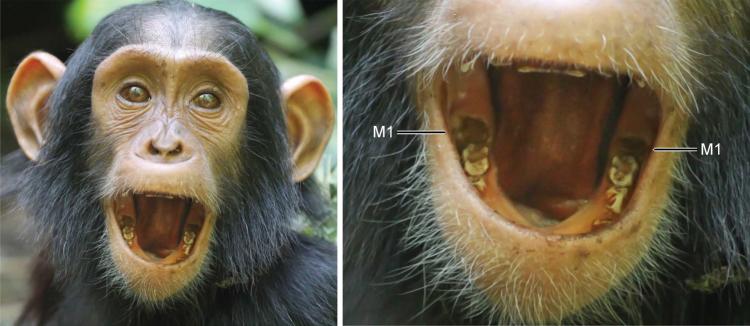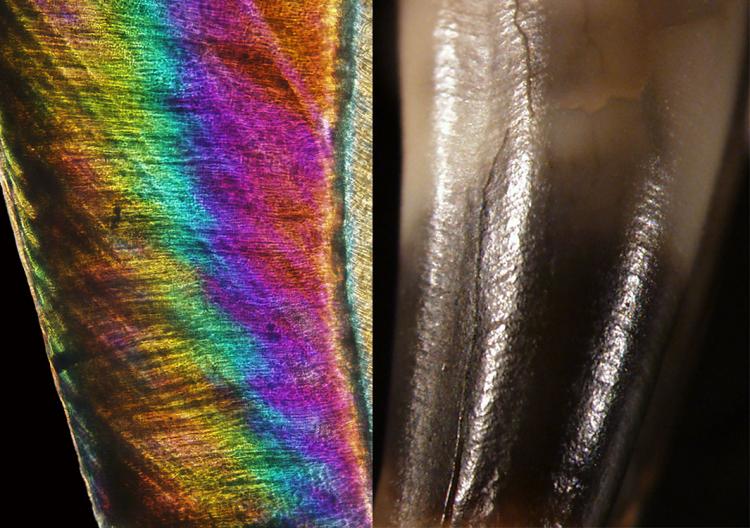Compared to those of other primates, our reproductive lives are really rather odd. Human pregnancies last relatively long, yet our babies are completely helpless when they are born. And while our children stop suckling very early, it takes them nearly two decades to grow up.
To understand how we have evolved to be like this, and how that may have set our species on its most unusual path, what we have are fossil remains — some skulls, bones and piles of teeth. Fortunately, those teeth can reveal a lot about the way that ancient hominins grew up. Evolutionary anthropologist Tanya Smith, of the Australian Research Centre for Human Evolution at Griffith University, has studied tooth development in fossilized Neanderthal children, as well as in wild chimpanzee infants. She wrote about the topic in “Teeth and Human Life-History Evolution” in the Annual Review of Anthropology.
This interview has been edited for length and clarity.
Do you study teeth because they are uniquely informative, or because they are often the only thing we have?
Both. Indeed, there are thousands of fossil teeth in museums all over the world, because they preserve quite well and each person has many, whereas if you wanted to study, say, ancient pinkie fingers you would be limited to a handful of specimens. Yet teeth are also unlike any other part of the body, in that they give us so many different types of information.
They lock in DNA in ways that other parts of the body don’t. They record the chemistry of the environment in the elements they incorporate during growth, telling us something about the food people ate and the water they were drinking. And because of the way their protective enamel layer grows — it is produced by cells that squeeze out about 1/200th of a millimeter of enamel every day — they also give us a record of time.
How can we access that record? How do you “read” teeth?
The 24-hour cycle of enamel production creates very fine lines in the enamel. You can’t physically hold up a tooth and point those out, however. First of all, you’ll have to slice it in two, to reveal its inner structure. You’ll also need a way to magnify it. This can be done with a strong microscope, or within a synchrotron, a particle accelerator in which items can be X-rayed with high resolution. If you look at teeth like that, you can see those lines very clearly.
Stress can lead to irregularities in the formation of those enamel lines, as it may slow down development or alter its course. Remember when you got the flu, as a kid, and you stopped eating for a few days, and you felt terrible? I do — I’ll never forget it. And I’m sure there’s a mark in my teeth from that week that I spent on the couch. That being said, there is currently no way for us to find the exact cause of a particular stress pattern in teeth — all stress shows up the same. People have been making up interesting stories about the possible cause of different irregularities, linking them to hunger or disease, but when you test these ideas in animals whose lives we know about, it turns out that a certain kind of stress does not predict a certain kind of developmental pattern.

Teeth record irregularities in growth that can signal times of stress, such as a change in diet. Here, a Neanderthal canine tooth, right, reveals a few such moments of stress. The first occurred at 2.4 years of age; the second, visible in the root, at 4.9 years. At left is a larger replica of the crown of the tooth.
CREDIT: COURTESY OF T.M. SMITH/ANNUAL REVIEW OF ANTHROPOLOGY 2013
The first thing I look for is whether a tooth is fully grown. If it is not, the number of lines will tell us how many days went by before the person died, giving us an age estimate. This way, we have learned that some Neanderthal children that have been studied were growing faster than we do.
Yet a recent study in Science on a juvenile Neanderthal from Spain suggests that this child grew about as fast as human kids do. How might that fit with what you've found?
I think we know enough about variation in the development of living species, including humans, not to draw sweeping conclusions from a single fossil. This was the first Neanderthal child that turns out to be slightly older than one would expect if its teeth would have developed in the same way that those of our children do. In the Neanderthal infants I’ve looked at, it was the other way around.
Why is it important to find out whether either species was growing faster?
In general, the faster you grow, the faster you reach adulthood and are ready to reproduce. Faster growth in Neanderthals suggests they had shorter childhoods, and is consistent with other studies suggesting that they lived shorter lives than modern humans do. Over the course of our evolution, lifespans have become longer: Wild chimpanzees have a life expectancy of roughly 30 to 50 years, and first reproduce when they’re 10 to 15 years old. Early hominins similarly reproduced and died at a younger age than we do. It’s interesting to learn when and how that changed.

In the open yaw of a 3-year-old female chimpanzee (Pan troglodytes schweinfurthii) in Uganda’s Kibale National Park, her first molars (labeled M1) are visible. Photographs such as these enable scientists to study tooth development in wild-living primates, providing insight into weaning and other shifts in diet.
CREDIT: T.M. SMITH/ANNU. REV. ANTHROPOL. 2013
For similar reasons, we are interested in the age of weaning — when infants cease to have mother’s milk. That tells us something about the rate at which mothers could have babies, since nursing will usually keep a woman from getting pregnant again. Our children are still very vulnerable when born, and they take a long time to grow up. Yet compared to our ape ancestors, early human mothers may have had children fairly often, with relatively little time between births. Some scientists believe that was possible because they were getting help from others in their group, such as their mothers or older children, the way many modern women do.
This might explain another unusual thing about humans: Women stay alive much longer than they make babies. If you only think of their own offspring, this seems hard to explain, biologically. But if they were helping out with the grandchildren, it makes sense. The ability to have multiple children within a relatively short span of time, combined with a long childhood in which we had plenty of time to learn, may have been key to our success.
What can teeth possibly tell us about the age of weaning?
Scientists have long believed that teeth show evidence of stress associated with weaning. The reasoning behind that idea is that children would often have gotten sick when they started to eat solid food, because their immune system would suddenly have to face many new microbes. Alternatively, some children may not have gotten enough food without mothers’ milk, leading to malnutrition. This can happen when mothers and infants are separated too soon or during periods of famine. But until recently, we didn’t really have a way to verify this idea. When we started to look at primates that we know went through these diet transitions, we didn’t see stress where it was predicted to occur. Recent work of ours also suggests that these things are more complicated than expected. For example, many researchers have assumed that the emergence of the first molar marks the age when children would switch to solid food. Yet in wild chimpanzees, we have found no such link: They may suckle for more than a year after that first molar emerged.
How do you study tooth development in wild chimpanzee infants?
There is no way to get them to sit still so we can look directly into their mouth to find out which of their teeth emerge when. Instead, we have used high-resolution pictures made by professional photographers. Each of them has spent about a year following a group of Ugandan chimpanzees, snapping a picture whenever an infant opened its mouth, so we could zoom in and have a closer look. I have recently visited the field site myself, and it was great to finally sit down with some of the animals whose teeth I have been studying for years. At the same time, it was quite a humbling experience: With my own camera —and limited skills — I couldn’t get a single image that I would have been able to collect any data from.
If tooth irregularities or the timing of emergence offer no clue to weaning, is there no other way to find out when those children whose fossils we study were weaned?
We have recently hit upon another option. Mother’s milk contains barium, and in collaboration with a toxicology lab in New York that is outfitted to analyze samples for metals that occur in very minute quantities, we can now detect barium in enamel layers formed while children were still being nursed. So hopefully we will soon be able to verify the link between the age of weaning and the occurence of stress marks in the teeth — at least in those we have access to, and are allowed to slice in half.

Tanya Smith and her colleagues’ counting and careful measurement of growth lines both within (left, false color diagonal lines) and on the outside (right, horizontal curved lines) of a Neanderthal tooth helped to determine that it belonged to a child who died at 8 years of age.
CREDIT: COURTESY OF TANYA SMITH
Using this approach, we have been able to show that an 8-year-old Neanderthal child found in a cave called Scladina in Belgium was drinking solely breast milk for about seven months, and was then fed both milk and solid foods for seven months after that. From that point on, it seems the child didn’t get any milk anymore. We think that this was a premature weaning event. It’s likely that the infant may have been separated from its mother or otherwise prohibited from nursing any longer.
There’s some real intimacy in that — being able to look at a fossil child’s life, finding out how he or she grew up.




